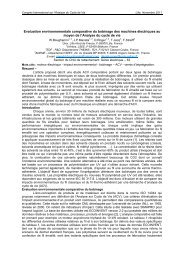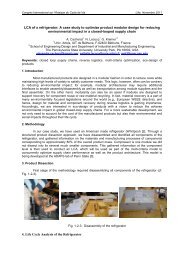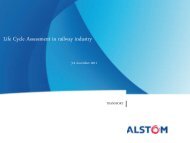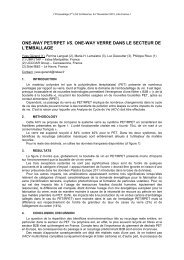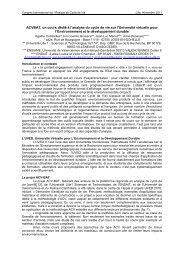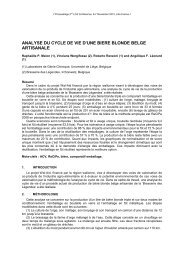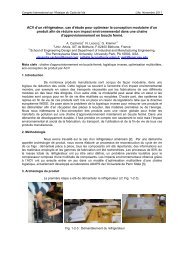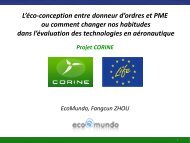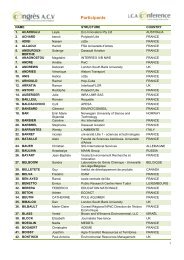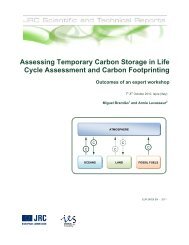Untitled - avniR
Untitled - avniR
Untitled - avniR
Create successful ePaper yourself
Turn your PDF publications into a flip-book with our unique Google optimized e-Paper software.
Congrès International sur l’Analyse du Cycle de Vie Lille, Novembre 2011<br />
Comparative environmental assessment of the electrical machines winding using the Life<br />
cycle assessment<br />
W.Boughanmi 1, 2 , J.P.Manata 1, 2 , D.Roger 1, 2 , T.Jacq 3 , F.Streiff 4<br />
1 Univ. Lille Nord de France, F-59000 Lille, France<br />
2 UArtois, LSEE, F-62400 Béthune, France<br />
3 EDF - R&D- THEMIS Department - R21, F-92141 Clamart Cedex, France<br />
4 ADEME - SEET Department - 20, Av Grésillé BP 90405, F-49004 Angers Cedex 01, France<br />
E-mail: mwalid.boughanmi@gmail.com, daniel-roger@univ-artois.fr<br />
Disciplinary section of the CNU: Electrical Engineering - 63<br />
Keywords: electrical motor – environmental impact – winding- LCA- impregnation varnishes.<br />
Abstract –<br />
The proposed article describes a comparative LCA study of the electrical machines winding<br />
resulting of two different technologies. The conventional process for realizing winding consists to use<br />
enameled wire with insulation based on monomer that deposited on the wire using solvents often harmful.<br />
The coils are made with this wire usually impregnated with varnishes that also use other solvents. The new<br />
manufacturing process for enameled wire is based on a UV polymerization process without solvent, also<br />
provides a thermo adherent composition for coil wire, which eliminates the final impregnation of the<br />
windings. This article assesses global environmental impact of the machine winding made with this new<br />
wire and compares it with that of a machine made with conventional wire using a LCA approach.<br />
Introduction<br />
Each year, approximately 30 million of new electric motors of all sizes, are sold worldwide, the total<br />
number of motors in the industry, infrastructure and large buildings is around 300 million. These motors<br />
use an enameled wire to realize its coils. An improvement even low of energy or environmental<br />
performance of each unit involves significant environmental benefits at the level of very large quantities<br />
associated. Enameled wire manufacture is a complex operation, energetically costly and relatively<br />
polluting, so this requires substantial environmental impacts. The conventional process of enameling<br />
consists of applying successive layers of very thin varnish on the copper wire [1]. The resins are<br />
monomers dissolved in solvents classified as harmful or carcinogenic products (cresols, aromatic solvents<br />
such as xylene, N-methyl pyrrolidone ...). The concentration of the resin in solvents is between 15 and<br />
40%, i.e. about 60% of the product used evaporates and must be treated which does not prevent a small<br />
part to be discharged directly in the atmosphere. In addition, the combustion of these solvents naturally<br />
generates a lot of CO2, which we know the environmental impact. An alternative solution has been<br />
developed in recent years; it is based on a UV polymerization process that uses no solvents. This new<br />
technology also allows a simple way to add an overlay over varnish-bonding. The aim is to remove the<br />
subsequent impregnation of the windings with varnish and other solvents. The electrical properties of new<br />
wire polymerized by UV were tested, they comply with requirements of IEC 60 317-8 standard. The<br />
purpose is to evaluate and compare the environmental impacts of conventional wire and thermo adherent<br />
wire using a life cycle assessment (LCA) approach.<br />
Comparative environmental assessment of the winding<br />
Eco-design of products and materials is described in ISO 14044 standard, which proposes a<br />
definition of life cycle analysis. The evaluation criteria of product environment impact are numerous, they<br />
provide quantitative and qualitative comparisons. This study follows the method developed by CML Leiden<br />
University (NL) in 1992, revised in 2000. Ten impact indicators are chosen. This study was carried out with<br />
SIMAPRO for the software side. The database used is version 2.2 of ECOINVENT which has several data<br />
on materials, processes, products and energies [2]. The comparative analysis is done using the example<br />
of an induction motor of 10 kW. Table 1 summarizes the different data used on the wire necessary for the<br />
winding. Except the specific values of table 1, other data used are those provided by the database<br />
ECOINVENT, both in the design phase as the end of life phase (for which a scenario of French waste<br />
standard was used).The materials used for coating copper wire in the manufacture of enameled wire,<br />
insulators are specific to highly specialized manufacturing process. They are not yet included in the<br />
databases that summarize the environmental impacts of materials more ‘’general public’’. Nevertheless,<br />
these insulators are modeled by a process of chemical similarity relying on data of simpler components<br />
that compose them. The environmental impact obtained in this way is obviously approximate and certainly<br />
minus from reality because the process that transforms these simples elements to resins ready for using is<br />
neglected.<br />
- 93 -



